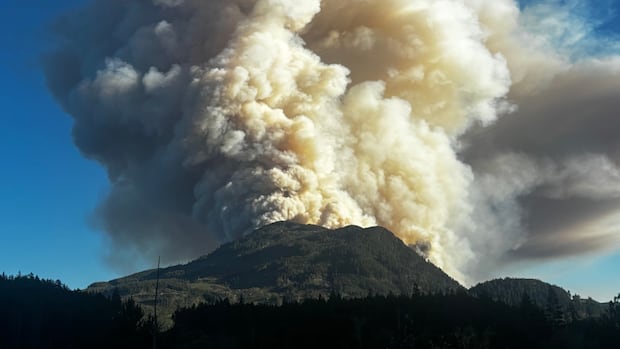[published_date]
As wildfires continue to threaten First Nations in northwestern Ontario, Pikangikum is facing another challenge: a community-wide power outage.
A Facebook post from Pikangikum First Nation band councillor Deedre Peters, posted on Sunday, says the remote Ojibway community has been without power for more than 24 hours.
Meanwhile, a fire known as Red Lake 62 has prompted an evacuation of Pikangikum’s most vulnerable. As of Sunday, the wildfire was more than 31,000 hectares large and not under control.
Ontario’s Ministry of Natural Resources issued an implementation order for the Red Lake 62 area on Saturday, limiting travel and the use of several lakes and roads.
On Thursday, the Ontario Provincial Police said more than 2,000 people from Pikangikum had been identified as requiring evacuation, starting Saturday. According to Peters’ post, more than 240 people were to be flown out on Sunday, though “a pause on broader evacuation is pending further instruction from the chief.”
Ben Curtis of the OPP Northwest Region told CBC News on Sunday that the evacuation is still very much in the early stages. So far, evacuees have been taken to Thunder Bay and Sioux Lookout, as leadership watch fire conditions to determine if people need to be moved to Toronto and Mississauga.
CBC News observed staff with the Independent First Nations Alliance (IFNA) assisting Pikangikum members at the Thunder Bay International Airport, but no one was available for comment.
Between 3,500 and 4,000 people live in Pikangikum, located in Treaty 5 more than 500 kilometres northwest of Thunder Bay. It’s one of the largest remote communities in the region.
Pikangikum’s nursing station is running on generator power without air conditioning and cannot support full operations, Peters said online.
Other critical buildings, such as elders’ complexes, are facing power shortages and overheating, while food spoilage is occurring due to freezer failures.
7:17The communities of Pikangikum and North Spirit Lake First Nations evacuate from wildfire threat
Evacuations of Pikangikum and North Spirit Lake First Nations in northwestern Ontario began on July 11, as out-of-control wildfires burn near the remote communities. The CBC’s Sarah Law spoke with Up North host Jonathan Pinto about the latest on the situation.
With shortages of food and fuel and “several patients” awaiting medical evacuations, Peters said that “general morale is low due to heat, outages, and uncertainty.”
Power could be restored by Sunday evening, he said, while telecom repairs aren’t scheduled to begin until July 21.
According to Curtis, the fire has been moving away from Pikangikum due to favourable wind conditions, which is allowing crews to build a fire break to protect the community. Power crews are working on restoring power, he said.
It is unclear exactly how close the fire is to Pikangikum at this time.
CBC News has reached out to Ontario’s Ministry of Emergency Preparedness and Response and is awaiting an emailed statement.
Smoke, haze has pros and cons
On Friday, just under 250 people from North Spirit Lake First Nation were flown to Thunder Bay due to a fire known as Red Lake 40, which measures at more than 11,000 hectares. From there, they were sent to Toronto.
“Firefighters have met with challenging conditions over the past several days as poor visibility due to smoke drift has limited the use of aircraft, as well as ongoing drought conditions in the Red Lake fire management area that support active fire behaviour on sections of the various fires,” fire information officer Alison Bezubiak told CBC News in an email Sunday afternoon.

More than 50 wildfires were reported in the region as of Sunday afternoon at various stages of control. While the smoke has made it harder for fire crews to tackle the blazes, at the same time, “haze has also led to higher relative humidity and less intense heat from the sun, which has helped to reduce fire activity.”
Still, “with skies beginning to clear near the Manitoba border and stronger winds in the forecast, an increase in fire behaviour is possible,” Bezubiak said.
The wildland fire hazard is low to moderate across much of the northwest, except for the western edge of the region along the Ontario-Manitoba border, where there hasn’t been as much rainfall.
“From the town of Fort Frances and spanning northward to Opasquia Provincial Park, the hazard is mainly high, with an area of extreme hazard around Weeskayjahk Ohtahzhoganeeng Provincial Park,” said Bezubiak.
Besides Red Lake 62 and Red Lake 40, other fires of note include Red Lake 67, west of McDowell Lake First Nation, at more than 32,000 hectares large, and Red Lake 72, east of Poplar Hill First Nation, at over 4,900 hectares.
Red Lake 12, the largest fire in the region, continues to be observed at more than 195,000 hectares, making it Ontario’s largest wildfire on record in terms of hectares burned.
Air quality statements continue
Well over a dozen air quality statements remain in effect in northwestern Ontario due to wildfire smoke, including for the City of Thunder Bay.
“We did have a low-pressure system move off into Hudson Bay, which will bring northwesterly winds over northwestern Ontario, so that’s kind of funnelling that smoke from those wildfires into the area,” said Kristina Kretchman, meteorologist with Environment and Climate Change Canada, in an interview with CBC News on Sunday.
Poor air quality is expected to persist Sunday night and possibly Monday before improving, she said. Symptoms include eye, nose and throat irritation, headaches or a mild cough.
“If you work outdoors, see if you can reduce exertion. Try to reschedule strenuous outdoor activities, seek medical attention if you’re experiencing symptoms,” Kretchman said.
“If you’re indoors, if you can, keep windows and doors closed as much as possible to prevent smoke from getting inside.”
More information about air quality statements in effect can be found at Environment and Climate Change Canada’s website. As well, people can access the province’s interactive forest fire map online for the latest on fires closest to them.



